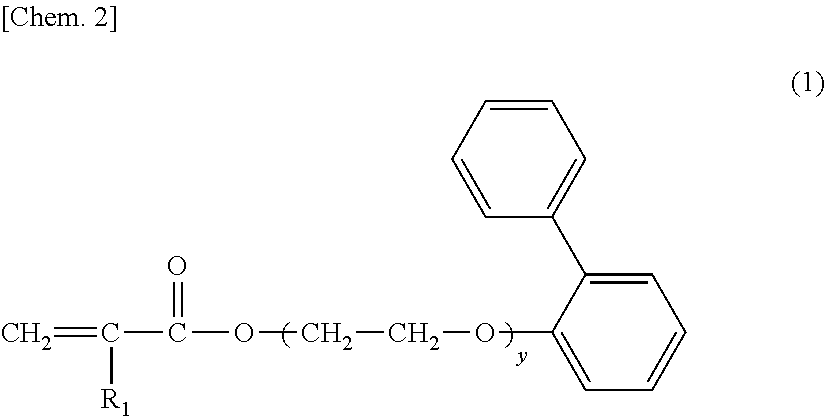Composition for colloidal crystal
a colloidal crystal and composition technology, applied in the field of colloidal crystal composition, can solve the problems of difficult colloidal crystals, high cost, and high cost, and achieve the effect of simple process and efficient manufacturing
- Summary
- Abstract
- Description
- Claims
- Application Information
AI Technical Summary
Benefits of technology
Problems solved by technology
Method used
Image
Examples
example 1-1
Synthesis of Core
(Core D)
[0138]A core was synthesized by two-stage seed emulsion polymerization. At the first stage, a 500-mL four-neck flask equipped with a condenser tube, a thermometer, an agitator, and a nitrogen inlet was charged with 0.146 g of a reactive emulsifier sodium styrenesulfonate (NaSS) and 350 g of ion-exchanged water. 13.72 g of a monomer methyl methacrylate (MMA) and 0.730 g of a cross-linking monomer ethylene glycol dimethacrylate (EGDM) were added to the flask, were mixed in a nitrogen stream, and were heated to 65° C. 0.0292 g of a polymerization initiator potassium persulfate (KPS) was then added to the reaction solution. After polymerization reaction at 65° C. for 5 hours, the reaction solution was cooled to room temperature.
[0139]At the second stage, 0.219 g of an emulsifier sodium dodecylbenzenesulfonate (DBS) was added to the reaction solution and was mixed at room temperature in a nitrogen stream. 0.730 g of a m / p mixture of 2-(4′-hydroxy-2′,2′,6′,6′-tetr...
examples 1-2 to 5-3
and Comparative Examples 1 to 5
Cores E to O
[0144]In the same manner as the core D, the cores E to 0 were synthesized using the amount of usage listed in Table 1. Table 1 shows the results.
[0145]The symbols in the following Tables 1 to 9 are as follows:
[0146]EMA: ethyl methacrylate
[0147]tBA: tert-butyl acrylate
[0148]tBMA: tert-butyl methacrylate
[0149]BDMA: 1,4-butanediol dimethacrylate
[0150]TFEMA: 2,2,2-trifluoroethyl methacrylate
[0151]St: styrene
[0152]BzMA: benzyl methacrylate
[0153]DVB: divinylbenzene (purity 55%, containing ethylvinylbenzene 45%)
[0154]HS-10: Aqualon HS-10 [manufactured by Dai-ichi Kogyo Seiyaku Co., Ltd.]
[0155]BPEA: 2-phenylphenoxyethyl acrylate (NK ester A-LEN-10 [manufactured by Shin Nakamura Chemical Co., Ltd.]) (see the following chemical formula)
[0156]BPA: 2-phenylphenyl acrylate (ARONIX TO-2344 [manufactured by Toagosei Co., Ltd.]) (see the following chemical formula)
[0157]BPM: 2-phenylphenyl methacrylate (see the following chemical formula)
[0158]LA: lauryl a...
PUM
| Property | Measurement | Unit |
|---|---|---|
| Fraction | aaaaa | aaaaa |
| Fraction | aaaaa | aaaaa |
| Percent by mass | aaaaa | aaaaa |
Abstract
Description
Claims
Application Information
 Login to View More
Login to View More - R&D
- Intellectual Property
- Life Sciences
- Materials
- Tech Scout
- Unparalleled Data Quality
- Higher Quality Content
- 60% Fewer Hallucinations
Browse by: Latest US Patents, China's latest patents, Technical Efficacy Thesaurus, Application Domain, Technology Topic, Popular Technical Reports.
© 2025 PatSnap. All rights reserved.Legal|Privacy policy|Modern Slavery Act Transparency Statement|Sitemap|About US| Contact US: help@patsnap.com



